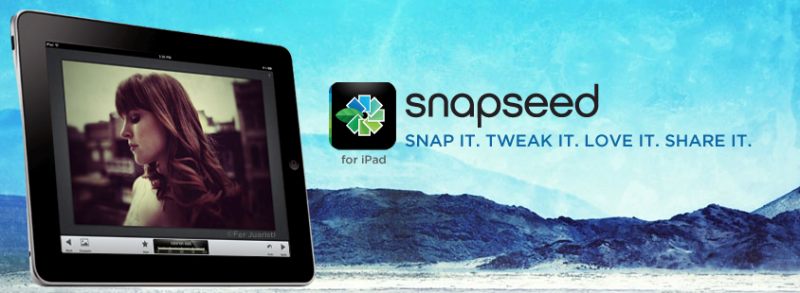Adobe, where are you?

Click for the Snapseed site
This $5 iPad app shows the progress being made in touchscreen photo processing apps. (Warning – I have not used it). Check out their video by clicking the above picture. The app uses the touchscreen technology well and the app is very much more than a toy. It includes area selection and smart masking for application of processing to selected areas. Check out the Selective Adjust video. The automasking is just the sort of magic the iPad is all about. Night and day compared to any other masking scheme I have seen, and entirely intuitive, Well done, Nik Software. Every user of digital sensors knows about their propensity to burn out highlights and this is just the ticket to fix those.
In its usual manner, Apple is squeezing the margins and disappointingly refused to increase the maximum storage when they release iPad2, the largest still limited to a modest 64gB. It’s not a hardware constraint. Tear downs of iPad2 disclose there’s lots of room in there for more flash storage. And given the rotten state of competitors’ offerings, Apple has no incentive to add storage at the present time.
Still, that will eventually come, and it’s important for photographers who want to work with RAW files rather than with compromised JPGs. What use is you super-duper DSLR with its phenomenal data capture if you are going tp throw most of the goodness away by working with compressed JPGs?
More flash storage is on the way. Intel is making huge strides with flash storage technology. The SSD recently installed in my HackPro used 32nM spacing (1nM = One billionth of a meter); it’s already obsolete, the current offering using 25nM, at a lower price. Once they cut that to 12nM, storage per unit area will quadruple and per unit volume it will be eight times as much. So help is on the way. With the typical RAW file coming in at some 15mB, 1000 RAW originals will need 15gB of storage or some 235 times the current maximum. With storage densities doubling annually we are 8 years away from that number. It wouldn’t surprise me to see it reached sooner, driven in large part by a burgeoning mobile computing market.
By that time, Intel’s high speed connectivity technology (which Apple would have the world believe is their invention, naming it Thunderbolt) will be the standard on all devices, mobile or not, so downloading your processed pictures from the iPad to your work computer will take seconds. Right now low USB transmission speeds are a huge bottleneck.
Meanwhile, where is Adobe in all of this? They own the serious/professional photo processing market though two outstanding applications, whether you are a Mac or Windows user. Lightroom and Photoshop. (Aperture’s market share is a rounding error). But Adobe’s poky touchscreen offerings for the iPad are underwhelming. Let’s hope they get on it before their faster, smaller competitors take the market from them. Why do I care? Because I want the functionality of exporting to LR or PS on my desktop and I sure as heck do not want to learn any new, big, complex apps which may replace it. I would rather be taking pictures.

I would rather be taking pictures. The Bubble. G1, kit lens.
A magic moment in a child’s life, spotted in San Francisco’s west Mission District.